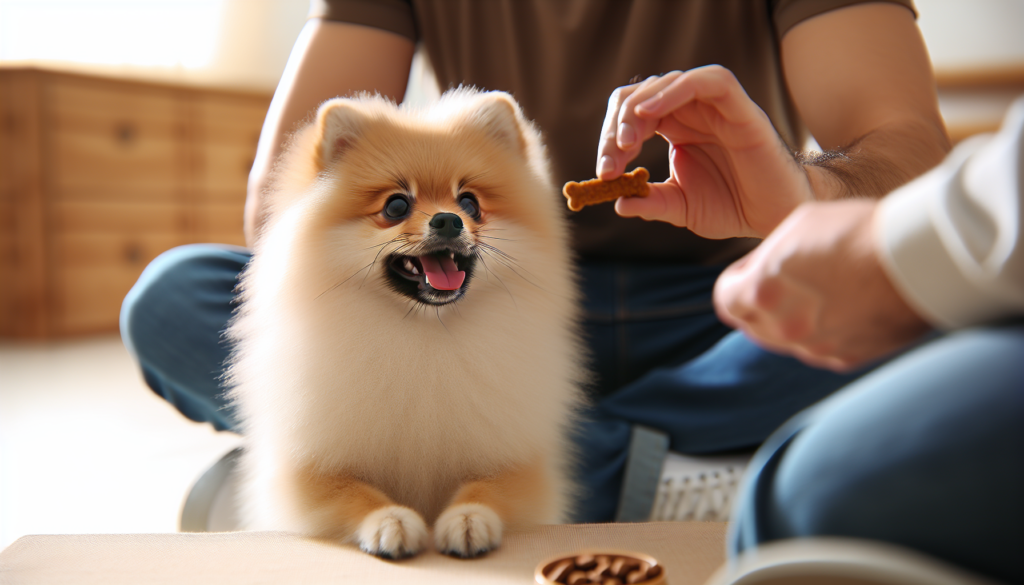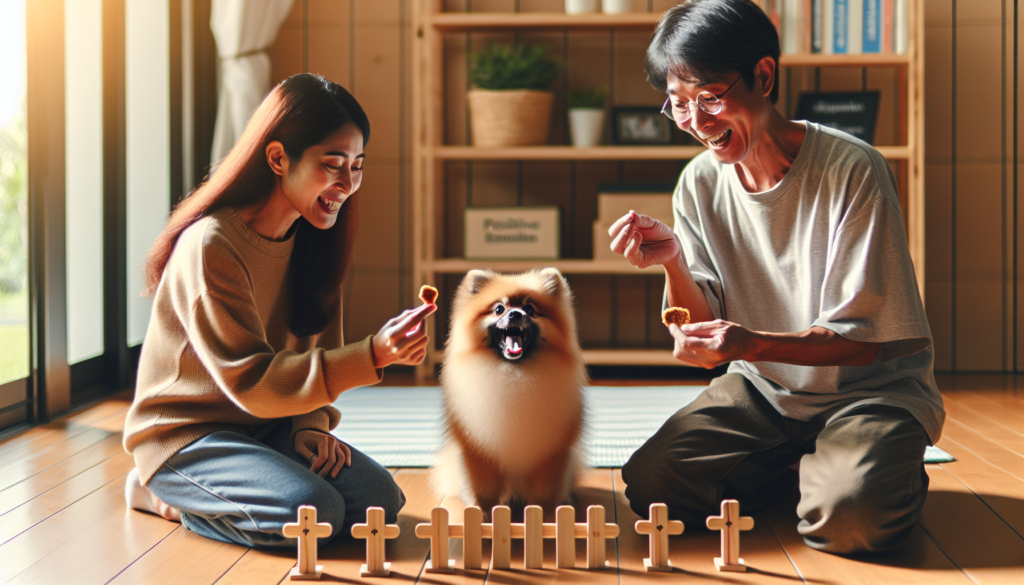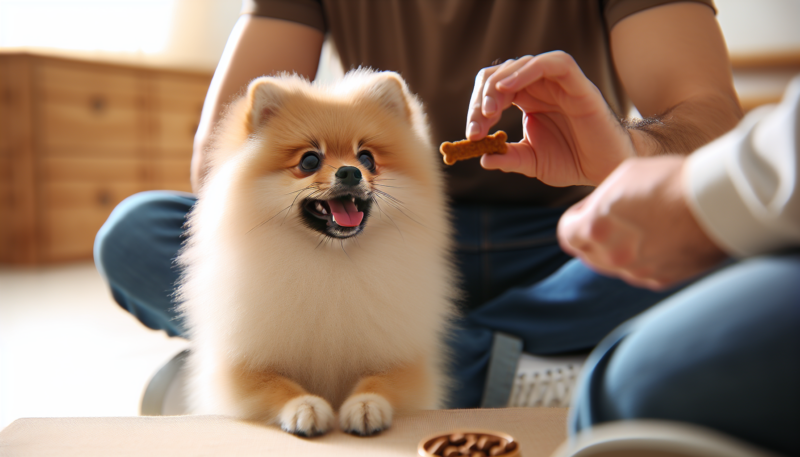If you’ve recently added a Pomeranian to your family, you may be wondering about the best training techniques to help your furry friend thrive. From potty training to basic commands, this article will provide you with valuable insights and tips on how to train your Pomeranian effectively. Whether you’re a new dog owner or simply looking to brush up on your training skills, this guide will help you create a strong bond with your Pomeranian and set them up for success. So grab a treat and get ready to embark on an exciting journey of training your adorable Pomeranian.
Pomeranian Training Basics
Training a Pomeranian can be a rewarding and enjoyable experience for both you and your furry friend. By understanding your Pomeranian’s behavior and building a strong bond with them, you lay the foundation for successful training. Setting clear expectations and using positive reinforcement techniques will help your Pomeranian learn and thrive. In this article, we will explore various aspects of Pomeranian training, including house training, socialization, problem behavior correction, advanced training techniques, health and exercise training, and specific training for Pomeranian puppies. Let’s dive in!
Understanding Your Pomeranian’s Behavior
Before you start training your Pomeranian, it is important to understand their unique behavior traits. Pomeranians are known for their intelligence, independence, and enthusiasm. They can sometimes display stubbornness or may be prone to anxiety if not properly socialized. By recognizing and understanding these behaviors, you can tailor your training methods accordingly.
Establishing a Bond with Your Pomeranian
A solid bond is the foundation of successful training. Spend quality time with your Pomeranian, providing them with love, attention, and positive experiences. Engage in activities that your Pomeranian enjoys, such as playtime or going for walks. This will help develop trust and a strong emotional connection between you and your Pomeranian.
Building Trust and Respect
To build trust and respect, it is essential to establish yourself as a reliable leader in your Pomeranian’s eyes. Use positive reinforcement techniques and reward desired behaviors. Avoid using harsh training methods or punishment, as this can damage the trust you’ve built. By being patient, consistent, and fair, you will earn your Pomeranian’s trust and respect.
Setting Clear Expectations
Clear communication is crucial when training your Pomeranian. Use simple, consistent commands and gestures to convey your expectations. Pomeranians are quick learners, so be clear and concise in your instructions. By setting clear expectations from the beginning, your Pomeranian will understand what behavior is expected of them.
Positive Reinforcement Training
Positive reinforcement is a highly effective training method for Pomeranians. This technique involves rewarding your Pomeranian with treats, praise, or affection when they exhibit the desired behavior. Here are some key aspects of positive reinforcement training:
Using Treats and Rewards Effectively
Treats are a powerful tool for motivating and rewarding your Pomeranian during training sessions. Choose small, bite-sized treats that your Pomeranian finds delicious. Use treats consistently to reinforce good behavior and reinforce desired actions. Gradually reduce the frequency of treats as your Pomeranian becomes more proficient in their training.
Clicker Training for Pomeranians
Clicker training is a popular method that enhances positive reinforcement. It involves using a clicker, a small device that makes a distinct clicking sound, to mark the desired behavior while simultaneously providing a treat. The clicker serves as an immediate signal to your Pomeranian that they have done something correctly. With consistent practice, your Pomeranian will learn to associate the sound of the clicker with positive outcomes.
Verbal Praise and Affection
In addition to treats and clicker training, verbal praise and affection play a vital role in positive reinforcement. Your Pomeranian craves your attention and approval, so use enthusiastic and encouraging words to express your satisfaction when they follow commands or exhibit good behavior. Petting, hugging, and giving belly rubs can also reinforce positive behaviors and strengthen the bond between you and your Pomeranian.

House Training
House training, also known as potty training, is an essential aspect of owning a Pomeranian. With patience and consistency, you can teach your Pomeranian where and when to eliminate. Here are some key points to consider:
Creating a Consistent Routine
Establishing a consistent routine is crucial for successful house training. Take your Pomeranian outside to their designated potty area at regular intervals, such as first thing in the morning, after meals, and before bedtime. Remember to praise and reward them when they eliminate in the appropriate spot. Consistency will reinforce the idea that outside is the designated area for elimination.
Using Crate Training
Crate training can be an effective tool for house training your Pomeranian. Introduce your Pomeranian to the crate gradually, making it a comfortable and safe space for them. Use the crate to limit their access to the house, especially when you are unable to supervise them. Pomeranians naturally dislike soiling their living area, so utilizing crate training can help them develop bladder control and reduce accidents indoors.
Rewarding Proper Elimination
When your Pomeranian eliminates in the appropriate spot outside, reward them with treats, praise, and affection. Make sure the reward is given immediately after they finish eliminating, so they associate the positive reinforcement with the act itself. This reinforces the desired behavior and encourages them to continue eliminating in the right place.
Dealing with Accidents
Accidents may happen during the house training process. It is important not to scold or punish your Pomeranian if they have an accident indoors. Instead, clean up the mess promptly using enzymatic cleaners to eliminate any lingering odors that may attract them back to the same spot. Focus on reinforcing positive behavior and continue with the house training routine.
Socialization and Obedience Training
Socialization and obedience training are essential for your Pomeranian to interact confidently with people and other animals. Here are some key areas to focus on:
Introducing Your Pomeranian to New Environments
Expose your Pomeranian to various environments, including parks, shopping centers, and different types of terrain. Gradually increase the level of stimuli, such as different sounds, smells, and sights, to help your Pomeranian become comfortable in new surroundings. Ensure that each experience is positive, using treats and praise to reinforce their calm and confident behavior.
Exposing Your Pomeranian to Various Stimuli
It is crucial to expose your Pomeranian to different types of stimuli to prevent fearfulness and anxiety. Introduce them to various sounds, such as vacuum cleaners, doorbells, or thunder recordings. Slowly increase the volume and intensity, rewarding your Pomeranian for remaining calm and not showing signs of fear. This will help them become resilient and less prone to anxiety in various situations.
Teaching Basic Commands
Teaching basic commands, such as “sit,” “stay,” “come,” and “down,” is fundamental for obedience training. Use positive reinforcement techniques and rewards to encourage your Pomeranian to follow these commands. Break the training sessions into short, focused intervals to keep your Pomeranian engaged and prevent them from getting bored or overwhelmed.
Walking on a Leash
Leash training is essential for your Pomeranian’s safety and for going on walks together. Start by introducing your Pomeranian to the leash and collar gradually, allowing them to get accustomed to the feeling. Begin practicing walking on a leash indoors, rewarding your Pomeranian for walking calmly beside you without pulling. Gradually transition to outdoor walks, rewarding them for good behavior throughout the process.
Training for Proper Behavior with Strangers and Other Animals
Pomeranians can sometimes exhibit fearfulness or aggression towards strangers or other animals. Proper socialization and obedience training can help address these issues. Gradually expose your Pomeranian to different people and animals, rewarding them for calm and appropriate behavior. Seek professional help if issues persist and never force your Pomeranian into uncomfortable situations.

Problem Behavior Correction
Pomeranians, like any other breed, may exhibit problem behaviors that require correction. By understanding common problem behaviors and employing effective training techniques, you can address these issues in a positive manner.
Understanding Common Problem Behaviors in Pomeranians
Common problem behaviors in Pomeranians may include excessive barking, separation anxiety, destructive chewing, or aggression. It is important to identify the underlying causes of these behaviors, such as fear, boredom, or lack of exercise.
Addressing Excessive Barking
Excessive barking can be a nuisance. To address this behavior, determine the triggers and redirect your Pomeranian’s focus to a more appropriate activity, such as playing with a toy. Use positive reinforcement to reward them for quiet and calm behavior. Consistency and patience are key when addressing excessive barking.
Dealing with Separation Anxiety
Pomeranians are known for their attachment to their owners, which can sometimes lead to separation anxiety. Gradual desensitization to being alone, providing interactive toys or puzzles, and creating a safe and secure environment can help alleviate separation anxiety. Seek guidance from a professional dog trainer or behaviorist if the issue persists.
Eliminating Destructive Chewing
Pomeranians, especially puppies, may engage in destructive chewing as a way to relieve teething discomfort or boredom. Provide appropriate chew toys and regularly rotate them to keep your Pomeranian engaged. Redirect their chewing behavior to the designated toys and avoid punishing them for chewing on inappropriate items.
Handling Aggression or Dominance Issues
If your Pomeranian displays aggression or dominance issues, seek professional help immediately. These behaviors can be dangerous and should be addressed with the assistance of a qualified trainer or behaviorist. They will be able to assess the situation, provide guidance, and develop a training plan tailored to your Pomeranian’s specific needs.
Advanced Training Techniques
Once your Pomeranian has mastered the basics, you can explore advanced training techniques to further challenge their intelligence and skills. Here are some areas to consider:
Teaching Tricks and Agility
Pomeranians are highly capable of learning tricks and participating in agility training. Teach them fun tricks such as “roll over,” “play dead,” or “fetch.” Agility training can stimulate both their mind and body, enhancing their overall well-being.
Advanced Obedience Commands
Continue building on the basic obedience commands by teaching your Pomeranian more complex cues such as “leave it,” “drop it,” or “heel.” These commands can be useful in various situations and further strengthen your Pomeranian’s obedience.
Off-Leash Training
Off-leash training requires a high level of trust, reliability, and obedience from your Pomeranian. Ensure that they have a solid recall command before attempting off-leash training in a safe and secure environment. Seek professional guidance to ensure a successful off-leash training experience.
Training for Therapy Work
Pomeranians can excel in therapy work, bringing joy and comfort to those in need. Consider training your Pomeranian to become a therapy dog, providing support to individuals in hospitals, nursing homes, or schools. Seek guidance from therapy dog organizations to ensure your Pomeranian meets the necessary criteria.
Health and Exercise Training
Keeping your Pomeranian fit and healthy is an important aspect of their overall well-being. Regular exercise, grooming, and veterinary procedures all require training and proper handling.
Keeping Your Pomeranian Fit and Healthy
Provide your Pomeranian with regular exercise appropriate for their age and health condition. Daily walks, playtime, and mental stimulation activities are essential to keep them physically and mentally stimulated. Consult with your veterinarian to determine the most suitable exercise routine for your Pomeranian.
Exercise Requirements for Pomeranians
While Pomeranians are small in size, they still require exercise to maintain a healthy weight and overall fitness. Aim for at least 30 minutes to an hour of exercise a day, which may include walks, playtime, or interactive toys. Adjust the duration and intensity based on your Pomeranian’s age and energy level.
Training for Grooming and Veterinary Procedures
Grooming and veterinary procedures, such as nail trims or teeth brushing, can be stressful for Pomeranians. Start training your Pomeranian from an early age to tolerate and cooperate during these procedures. Gradually introduce them to grooming tools and provide positive reinforcement throughout the process. Seek professional grooming assistance if needed.
Training for Specific Pomeranian Traits
Pomeranians may exhibit certain traits that require specialized training approaches. Let’s explore some common traits and how to address them:
Addressing Fearfulness and Shyness
Fearfulness and shyness can be common in Pomeranians. Gentle socialization, exposure to various stimuli, and positive reinforcement training can help build their confidence and reduce fear. Patience is key when working with a fearful or shy Pomeranian.
Training for Excessive Barking
Pomeranians have a tendency to be vocal and may bark excessively. Provide appropriate mental and physical stimulation to keep them engaged and reduce boredom-induced barking. Use positive reinforcement to reward quiet behavior and teach a “quiet” or “enough” command to help control excessive barking.
Coping with Needy or Attention-Seeking Behavior
Pomeranians are known for their need for attention and may exhibit clingy or needy behavior. Set clear boundaries and provide mental and physical stimulation to prevent excessive attention-seeking behavior. Use positive reinforcement to reward independent and calm behavior.
Training for Nipping or Biting Tendencies
Some Pomeranians may display nipping or biting tendencies, especially during play. Teaching bite inhibition from an early age is crucial, as well as redirecting their attention to appropriate toys and rewarding gentle play. Seek professional help if nipping or biting behavior becomes a safety concern.
Training for Pomeranian Puppies
Training Pomeranian puppies requires a different approach compared to adult dogs. Here are some key areas to focus on when training a Pomeranian puppy:
Introduction to Basic Training
Start training your Pomeranian puppy from an early age to establish good habits. Focus on basic commands such as “sit,” “come,” and “stay.” Keep training sessions short and fun to avoid overwhelming your puppy.
Socialization with People and Animals
Expose your Pomeranian puppy to a wide range of people and animals during their socialization period, which is typically between 3 to 14 weeks of age. Provide positive experiences and rewards during these interactions to help them develop confidence and positive associations.
Potty Training for Puppies
Potty training is a priority when it comes to training a Pomeranian puppy. Follow a consistent routine, reward proper elimination, and be patient during the learning process. Pomeranian puppies have small bladders, so they may need to go outside frequently.
Teething and Appropriate Chewing
Pomeranian puppies go through a teething phase, which can lead to chewing on inappropriate items. Provide them with suitable chew toys to redirect their chewing behavior. Avoid punishing them for chewing, as it is a natural behavior during this stage.
Training Challenges and Tips
Training a Pomeranian can sometimes pose challenges. Here are some tips to overcome common training obstacles:
Patience and Consistency
Patience is vital during the training process. Pomeranians, like any other breed, require time to grasp new concepts and behaviors. Stay consistent with your training methods and expectations to avoid confusion.
Avoiding Harsh Training Methods
Harsh training methods, such as yelling or physical punishment, should be strictly avoided. These methods can cause fear or aggression in your Pomeranian and damage the trust and bond you have established. Focus on positive reinforcement and reward-based training.
Seeking Professional Help if Needed
If you are facing difficulties or if your Pomeranian exhibits severe behavior problems, seek assistance from a professional dog trainer or behaviorist. They can provide guidance, assess the situation, and develop a personalized training plan for your Pomeranian.
Addressing Regression in Training
Pomeranians, like any other dogs, may experience regression in their training progress. This can occur due to changes in routine or exposure to new environments. Be patient, revise your training techniques, and reinforce previously learned behaviors to overcome regression.
Keeping Training Sessions Fun and Engaging
Make training sessions enjoyable and fun for both you and your Pomeranian. Incorporate play and interactive games into your training routine to keep them engaged and motivated. Remember to be positive and rewarding during each session.
Training is an ongoing process throughout your Pomeranian’s life. With patience, consistency, and positive reinforcement, you can shape your Pomeranian into a well-behaved, obedient, and happy companion. Enjoy the journey of training your Pomeranian and revel in the special bond that develops between you and your furry friend.
